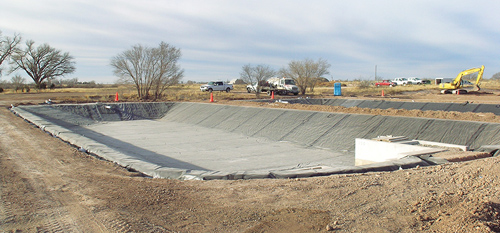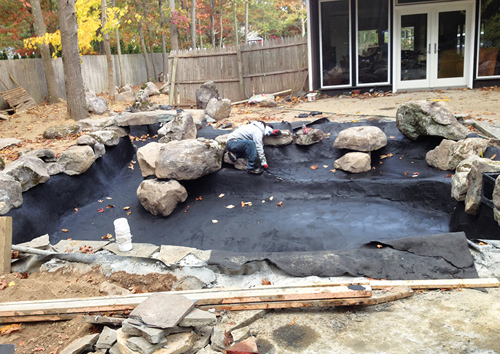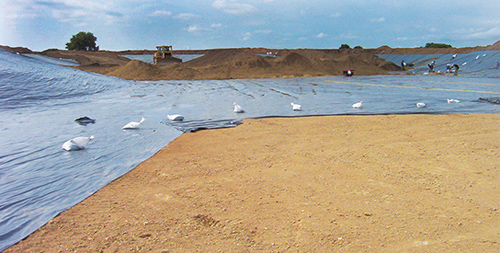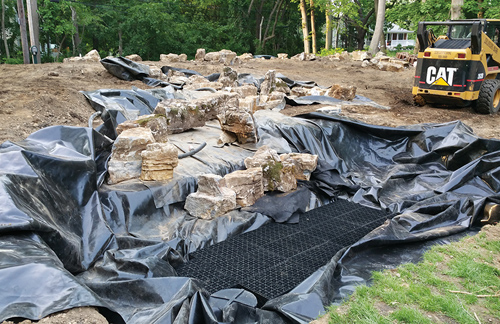
Ponds and lakes come in a variety of shapes and sizes. No matter if it’s a small backyard water garden, a rain catchment basin, a fish farm pond, a stormwater basin, an irrigation lake or a recreational and storage reservoir…in order for it to adequately hold water, the basin must be constructed of a low-permeability or impermeable pond liner that will seal the structure —“ or greatly limit seepage.
The engineering community uses testing and known equations to calculate seepage rates, or permeability, through various materials. This is typically expressed in feet per second (ft/sec) or centimeters per second (cm/sec) and indicates the rate at which water would flow through the material.
Sand and gravel, for instance, are highly permeable and can be expressed as 1 x 10-2 or 10-3 cm/sec. Compacted clay and/or soil-amended clay can seep at rates of 1 x 10-5 all the way down to 1 x 10-10 cm/sec. Properly constructed concrete can get even lower permeability rates, such as 1 x 10-11. Liquid-applied synthetics and premanufactured synthetics are technically impermeable, so moisture vapor transmission rates are used to calculate their relative permeability, which is often as low as 1 x 10-12 or 10-13.
These numbers are fun to think about, but in reality, what does this mean? In a 400-square-foot area, gravel would seep over 300,000,000 gallons per year and sand over 30,000,000. Clay would vary between 3,000 and 30,000, and amendments could impact this 10 to 20 percent. Concretes and synthetics would seep less than 20 gallons per year.Factors to Consider
Selecting a liner is based on a variety of factors. Obviously, low permeability is critical, as this is directly related to the purpose for the liner installation. However, in areas of high rain and/or runoff that will help keep a pond at the desired water level, we can choose products at the upper end of a good scale of permeability (1 x 10-6 cm/sec) specification. In areas prone to drought or long periods without rain or runoff, we should target the lower end of the scale (1 x 10-11 or less).

Durability is another key factor in selecting a liner. Unless the desired life of a project is very short, we want something that will last long and hold up to the environmental conditions in which it is installed. Liquids generally have great mass, so adequate structure to support the containment is, for obvious reasons, critical.
Selecting a liner well-suited to the application is also very important. Choosing the wrong liner can lead to chemical attack, dead fish and reductions in the quality of the liquid contained.
The conditions of the site —“ including what kinds of equipment will access the area, high winds and dust, existing drainage and other factors —“ can dictate the type of liner best suited to the project. Also, sealing to numerous detail structures such as pipes, walls and corners can affect liner selection and success.
And, of course, we must consider value. I say “value” instead of “price” because I believe there is a balance between the initial price, installation time and maintenance and repair of issues and problems that arise during the service life. There seems to be a segment of the market that does not have the funds to do it right initially but does have the funds to do it over. Searching for the best value is aimed at avoiding this scenario.
Each type of liner has advantages and disadvantages in performance. The balance of this article will address those qualities and hopefully give readers some insight into what it takes to select, then successfully install, low-permeability liners. The liners I have chosen to discuss are: clays, amended soils, concrete, liquid applied and manufactured synthetic liners.
Natural Options
Clays and soil-amended liners are nature’s best barriers. Good clays have small particles that expand in moisture, subsequently “plugging” existing gaps that water can seep through. If a good quality clay is on-site, it is usually the most cost-effective product to install. Clays can be tricky, as low PI (plasticity index) values won’t result in the best barriers. Clay installation requires a large carbon footprint to install and, when left exposed to the elements, clay can dry and desiccate, leading to cracking and leakage. Wet/dry and freeze/thaw cycles can damage the liner’s efficacy.

There are both natural and polymeric soil amendments that will decrease permeability. Sodium Bentonite has a very high swell rate and, when wetted, will plug up gaps in soil. Permeability can be reduced several orders of magnitude with this process. Polymeric additives function similarly. Success increases as the product is tilled into the soil, wetted and then compacted. As with clay, this has a higher carbon footprint and when exposed will be subject to the same drying and desiccating qualities of clay. There are applications where these products are applied in existing ponds full of water. The theory is that the particles will flow to the leaks and start to plug them.
Concrete
Concrete offers the best structure of all liner types. When installed properly, using the right reinforcements and psi values, it offers a long-term, low-permeability liner. Concrete is typically more expensive than the other types of liner, is susceptible to cracking and can affect the pH of the water during the initial phase of operation.
Synthetic Options
Liquid-applied membranes may be sprayed or applied by roller. These membranes offer very low permeability and install seamlessly, with no folds or wrinkles on the surfaces to which they are applied. The surface must have adequate structure and be properly prepared. The thickness of the applied membrane can be operator-dependent, so choosing someone with successful experience is strongly recommended.

Synthetic manufactured membranes are also very low-permeability products. Compared to liquid-applied membranes and concrete, they can be very cost-effective. Since they are manufactured in a controlled environment, the quality and uniformity of the product is typically very high. Synthetic membranes can be supplied in large panels to minimize or even eliminate field seaming. These liners do not have structure and must be placed on properly prepared subgrades. They are generally thin (20 to 80 mils) and can, unless placed on smooth ground, run the risk of penetration. The ability of these liners to withstand chemical attack, resist ultraviolet exposure and be “fish friendly” varies greatly.
Choosing a Synthetic
The basic varieties of synthetic membrane liners are polyethylene, PVC, EPDM and polypropylene. Choosing between these four types of liner can be very challenging, as manufacturers list product specifications that can get confusing.
Take, for example, puncture resistance. Lab puncture test using sharp probes to measure the force required to penetrate the liner will get different results from lab puncture tests using hydrostatic pressure over simulated rocks. Elongation is often calculated from two-dimensional tests and only break strength is recorded —“ omitting yield, which is the crucial measurement of the actual point at which the material properties alter, rendering the liner susceptible to breach. Polyethylene has excellent strength and chemical resistance but very poor elongation. PVC has very good elongation and decent strength, but in the presence of sunlight it can become brittle. Polypropylene has good strength and good elongation but has had varied success in exposed applications. EPDM has the best elongation and UV resistance but limited chemical resistance. One would be wise to look at installations where liners have been successful over long periods of time before selecting a liner for a particular project.
Success-Based Decisions
As you can tell from the above, liner selection can be complex, and maybe even complicated. However, as with most things, looking for good records of success is always a good place to start. All of the above liner types have been installed successfully —“ and have experienced failure. Selection becomes a process that involves the right input up front during design to narrow the options, the right techniques used to install the liner and clear understanding of the maintenance involved with the particular liner chosen. During the design process, some of the questions that need to be answered are: What is the application? What is the desired appearance? What is the expected life of the project? What is the annual rainfall, and how does the site drain? What are the existing soil conditions? What regulations or permitting will be involved?
Regarding installation, seek answers to questions like these: What are we good at? What kind of equipment can I get to the site? Is adequate power available? Is there space to store product before and during installation? What inspections will I perform to ensure success?
Then, looking at maintenance, consider site issues like drainage, groundwater, erosion, drought, flood, et cetera. All of these factors can affect the success of a liner. But with proper consideration, you can choose the perfect one for the job.



I had no idea that concrete offers the best structure of all liner types. We have a natural pond in our backyard that we are in the process of remodeling to look nicer. We first need to get out the wild carp that are in there. I will be sure to keep this in mind when remodeling!
Thanks, Paul. This information is helpful for me as I am in the process of building a pond in a terrain that is clay with low permeability. I don’t know the feet-per-second but it holds water. The pond is about 60 ‘ * 40′ * 8’ deep. There is some ground water which seeps into the pond.
I’m trying to make a swimming pond. I’d like the water to be clear and support water plants around the sides on shelves. Presuming I leave it natural and do not install a liner – should I be concerned about clay particulates “muddying” the water (I thought maybe a liner would keep the particulates down)? I was considering using a strip of liner encircling the planting shelves around the pond, like a skirt, and then having a lot of pea gravel in the areas where a swimmer would walk etc.
Any advice would be appreciated
John, sounds like a beautiful pond, I would love to see a photo when you finish construction. It is important to remember that pond water clarity is different than pool water clarity. Chemicals kill everything in a pool to keep it clear which of course we cannot do with a pond. Clarity can vary based on seasons and environmental conditions along with filtration, circulation and flocculation, but seldom is achieved by the liner used. I have 3 comments. 1. Ground water is a problem whether lined with synthetic or natural liner. It can lift the synthetic liner above the pond surface and if the ground water elevation fluctuates it can cycle in and out of your natural liner effecting the pond water level. So either way you line it, addressing the problem during design and construction will save you a lot of headaches during operation and enjoyment. 2. Clay particulates can cause the pond to appear murky. A natural liner can also be a place phosphorous builds up, escaping to feed algae or other undesirable weed. Diffused aeration can help buffer this so I would suggest adding one to your design. 3. I love the plant shelf idea and lining it with a synthetic liner. Plants are natures best filters. You may want to consider circulating your pond water through your plant shelf functioning like a wetland or bog filter. Hope this helps.
RPE by http://www.btlliners.com
Best choice for your money.